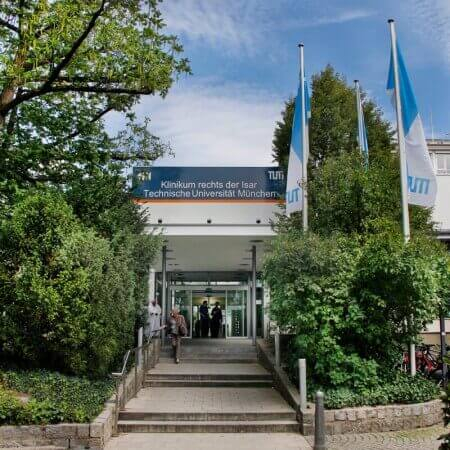Ovarian cysts are one of the most common gynecologic diseases. Approximately 5% of women undergo at least one operation to remove a cyst during their lifetime. You can opt to undergo treatment in Germany, where the intervention will be minimally traumatic and safe. Do not hesitate to use the Booking Health service to find out the cost of treatment and choose a medical care program at the best price.
Content
- What is an ovary cyst?
- Diagnostics
- Who may need treatment?
- Principles of surgical treatment
- Extent of surgical procedures
- Surgical approaches
- The cost of treatment in Germany
What is an ovary cyst?
A cyst refers to tumor-like formations of the ovaries. It looks like a cavity filled with liquid. This is a benign neoplasm. Nonetheless, in about 10% of cases, malignant cells are found after cyst removal, and such patients subsequently require cancer treatment.
Cysts can be quite different, and they can be divided into the following two groups: functional and organic.
Functional cysts are associated with the normal functioning of the ovaries. They appear and disappear at random among all women. Such formations include corpus luteum (luteoma) and follicular cysts.
Normally, cavities filled with fluid appear in women's ovaries every month. They are called follicles. In the middle of the menstrual cycle, the dominant follicle ruptures with the release of a mature egg. But such formations have a diameter of about 2 cm. Anything larger than 3 cm is considered a cyst. Cysts under 6 cm in size are considered safe, but if they become larger, the risk of complications increases, including pedicle torsion and ovary rupture. In addition, the large size of the formation and its constant growth may lead doctors to think about oncology. Therefore, in such cases, a patient is usually offered surgery to remove the cyst.
Organic cysts cannot vanish on their own. They are the reason for the operation to remove the formation. These include endometrioid and dermoid cysts, serous and papillary cystadenomas. Parasitic and traumatic cysts are not common.
Diagnostics
In two out of three patients, a cyst causes no symptoms. It may be detected incidentally on an ultrasound scan for another condition.
Symptoms manifest themselves in one out of every three patients. The most common are abdominal pain and menstrual disorders. Rare symptoms that develop in 5% of women or less are the following:
- postmenopausal bleeding;
- urinary abnormalities;
- conception problems;
- constipation;
- abdominal enlargement.
Some cysts reach gigantic sizes, which are measured in tens of centimeters. They can be easily palpated through the abdominal wall. Approximately 15% of women go to a doctor with complaints of a massive formation in their abdomen. The cyst becomes accessible for palpation with a diameter of 10 cm in thin women and of 15 cm in patients with developed subcutaneous fat.
The diagnostic process begins with a clinical assessment, which includes examination, palpation, a gynecological examination, and an examination of the cervix of the uterus in the mirrors. An ultrasound scan can be used to detect cysts. This is a very accurate method that allows doctors to distinguish a liquid formation from a dense one with an accuracy of 97% and a benign neoplasm from a malignant one with an accuracy of 76%. Based on ultrasound signs, doctors can assess the risk of cancer, determine indications for cyst treatment, and choose the optimal method of surgical intervention.
Occasionally, doctors at the German clinics use an MRI scan for diagnostics. A test with contrast enhancement helps to more effectively distinguish between benign and malignant ovarian neoplasms.
Who may need treatment?
Not all women need treatment. Functional cysts are usually not treated, and a woman is only monitored. Treatment will be provided if clinically indicated. If the cyst is organic, this is a reason for its surgical removal.
The following are some treatment options for functional cysts:
- the size of the formation is more than 7 cm (in the recommendations of some countries, the operation is indicated for a size of 6 cm or more);
- the presence of symptoms associated with the availability of the neoplasm in the ovary;
- development of acute complications, such as torsion or rupture of the ovary;
- an increase in the size of the cyst for three months in a row;
- the formation's size does not decrease after 6 months of medical supervision.
The goal of treatment for such cysts is primarily to prevent ovarian cancer. Follicular cysts usually disappear within 3 months. If this does not happen, a doctor may suspect oncology. An ultrasound scan, an MRI, and tumor marker tests help to assess the risk of a malignant process, but the most accurate diagnostic method is a histological examination. An ovarian biopsy is not performed, since if there are cancer cells, they will enter the abdominal cavity. Metastases will thus form, making it difficult to provide further cancer treatment. Therefore, suspicious cysts are removed entirely and then examined in the laboratory.
Principles of surgical treatment
The surgical treatment of ovarian cysts in Germany is aimed at the complete removal of these formations along with their capsule. In this case, the risk of relapse will be minimal.
At the same time, doctors strive to preserve as much normal ovarian tissue as possible. Most patients with cysts are women of reproductive age who may be planning a pregnancy in the near future. The more sparing the effect on the ovaries, the lower the risk of infertility, and the longer fertility will be preserved.
Treatment in Germany is provided with the help of organ-preserving operations to minimize damage to reproductive function. Doctors strive to preserve at least part of the ovary even in patients with large cysts. Whenever possible, they use only cyst enucleation with full preservation of normal ovarian tissue. When performing the operation, doctors at German clinics use sparing methods of hemostasis. These hemostasis procedures use hemostatic drugs rather than electrocoagulation or other energies. So doctors manage to avoid burns and the death of normal ovarian tissues in the area of the cyst.
When removing a cyst, doctors at German hospitals do not forget that there may be components of a malignant tumor inside. Therefore, they evacuate the formation inside a sealed container. They try not to damage the cyst to prevent the dispersion of fluid with cancer cells throughout the abdominal cavity.
Extent of surgical procedures
To what extent the tissues and organs of the female reproductive system will be removed depends on a number of factors:
- type of the cyst;
- cancer risks (calculated by ROMA, IOTA, and RMI indices);
- size of the formation;
- woman's age;
- the presence of reproductive plans;
- ovarian reserve before surgery.
Options for operations, depending on their extent, may be the following:
- a cystectomy is the main operation at German clinics and involves cyst enucleation with full preservation of normal ovarian tissue;
- a resection of the ovary is a surgical procedure for partial removal of the organ along with the cyst;
- an adnexectomy aims to completely remove the ovary along with the fallopian tube on the side of the lesion;
- an oophorectomy is an operation to completely remove the ovary while preserving the fallopian tube;
- a bilateral adnexectomy is performed to remove both ovaries and fallopian tubes (this operation can sometimes be performed in menopausal women).
Surgical approaches
The type of surgical approach determines the trauma of the intervention, the risk of complications, blood loss, recovery time, and severity of postoperative discomfort, as well as the number and size of abdominal scars, which is also important for young women. The main types of surgical approaches that are used in gynecology for the removal of ovary cysts are the following:
Laparotomy is a classic operation performed through a large abdominal incision. This treatment option is not common in Germany, although it is still considered a standard treatment in countries with a low level of medicine. It takes a long time to recover after such operations. A woman can spend up to 2 weeks in the hospital and can return to her usual life after 2 months.
Laparoscopy is a standard technique for performing surgery in gynecology in Germany. Such operations imply several small incisions, a little more than a centimeter in size, instead of one large incision. One of the incisions is slightly larger than the others so that the removed tissue can be extracted. Thin, long instruments and a tube with an attached video camera are inserted through the punctures. A doctor performs the surgical procedure by operating the manipulators, and his hands are not immersed in the wound. The recovery time after such interventions is much less. After two weeks, a woman can return to her usual life.
Single-port laparoscopy (single laparoscopic approach) is performed through a single incision in the navel. This type of surgery takes longer but can reduce trauma. The aesthetic result improves since only one abdominal scar remains instead of 3-4. If you want to have single-port laparoscopic surgery, the Booking Health staff will find the best German clinic that specializes in such procedures for you.
Transluminal surgery (NOTES, natural orifice surgery) is the least traumatic method of the operation. Doctors insert instruments through the vagina. A scar remains inside, and there are no scars on the abdomen as a result of this intervention, which provides the best aesthetic result among all surgical approaches. In addition, patients experience less severe postoperative pain and recover faster and easier after transluminal surgery.
Both single-port laparoscopy and the NOTES operation cannot be used for 3-4 grade pelvic adhesions. Physicians may begin to operate with these techniques on patients with grade 1-2 adhesions, but there is still the risk of switching to standard laparoscopy through multiple abdominal incisions.
The cost of treatment in Germany
You can find out the cost of treatment and compare prices at different hospitals on the Booking Health website. Germany offers top-class medical care. Doctors will treat your ovarian cyst with a minimally traumatic operation, preserving the ovary. The specialists will ensure a good aesthetic result and a short recovery time.
There are a few reasons for you to undergo your treatment of ovarian cysts in Germany. These are the following:
- modern Gynecology Centers equipped with the latest technology;
- the majority of operations in Germany are performed using minimally invasive laparoscopic techniques;
- some hospitals use innovative types of operations, such as single-port laparoscopy, NOTES, and robotic surgery;
- speedy recovery, minimal postoperative discomfort, and no large abdominal scars;
- doctors at German clinics take measures to prevent fluid from entering the abdominal cavity from the cyst since, in 10% of patients, it contains cancer cells;
- a low risk of complications;
- preservation of ovarian reserve and reproductive function.
When you choose your medical care program through the Booking Health service, the cost of treatment will be lower than when you seek medical attention directly from the hospital. The price will be reduced due to the absence of taxes for foreign patients. Our company's employees will fully organize your trip and translate your medical documents into German. They will also provide an interpreter in Germany and take care of your transfer from the airport to the hospital and back.
Authors:
The article was edited by medical experts, board-certified doctors Dr. Nadezhda Ivanisova and Dr. Vadim Zhiliuk. For the treatment of the conditions referred to in the article, you must consult a doctor; the information in the article is not intended for self-medication!
Sources:
Centers for Disease Control and Prevention
Healthline




















